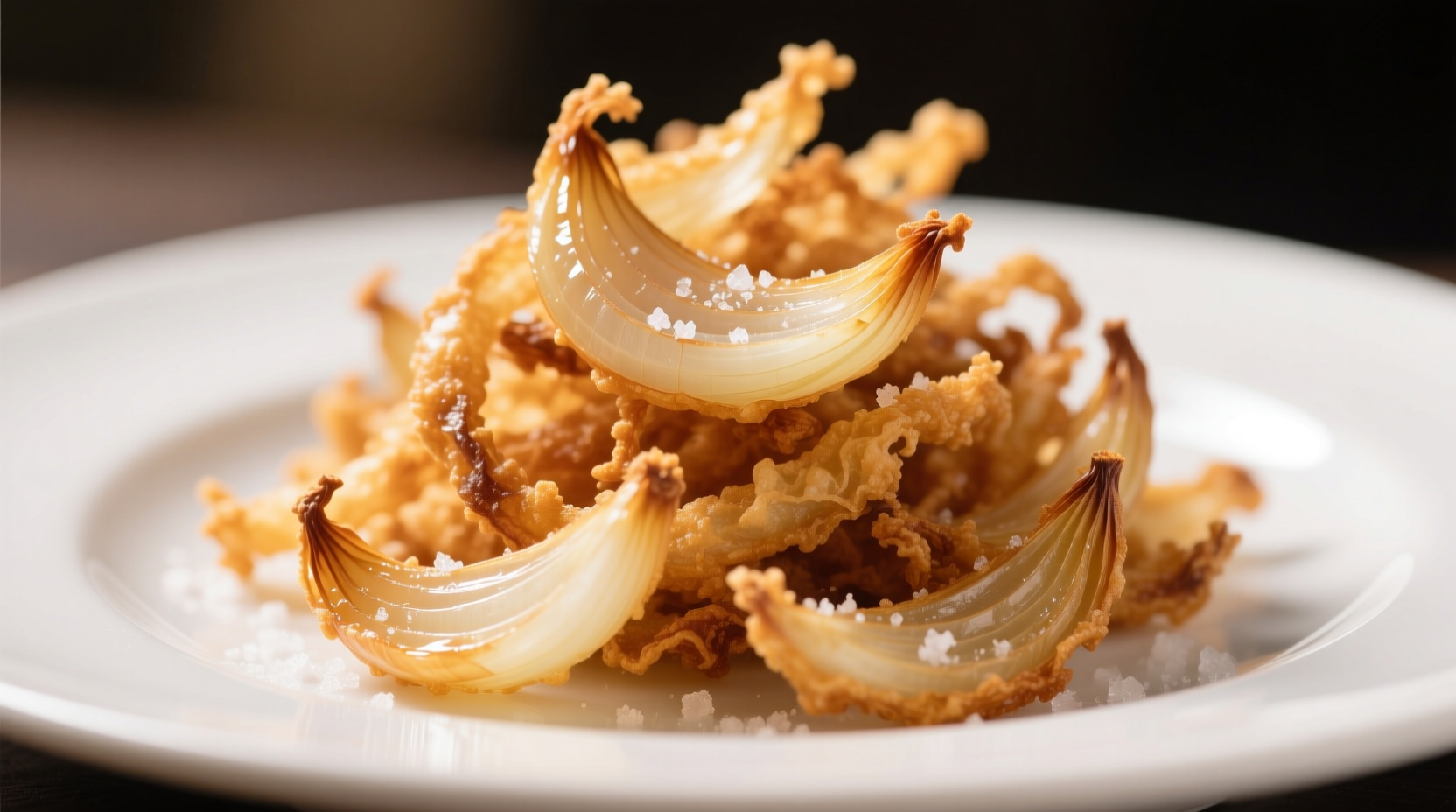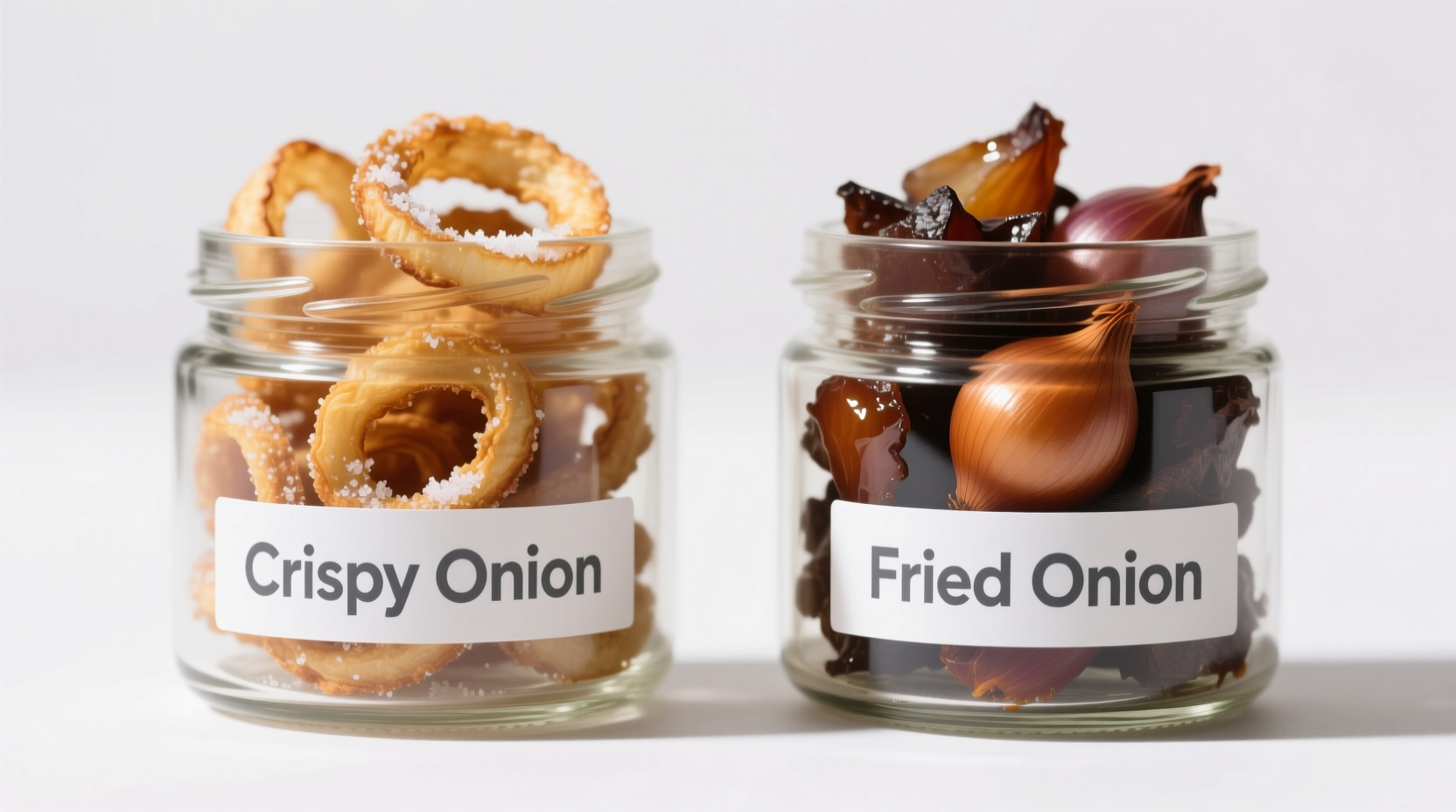Ever wondered why your onion toppings turn out soggy instead of shatter-crisp, or why your stir-fry lacks that rich caramelized foundation? Understanding the difference between crispy onion and fried onion techniques transforms your cooking results. These two preparation methods create fundamentally different textures, flavors, and culinary applications despite using the same humble ingredient.
Why This Distinction Matters in Your Kitchen
Mastering both techniques unlocks professional-level cooking skills. Crispy onions add textural contrast and visual appeal as finishing elements, while properly fried onions build foundational flavors in countless dishes worldwide. Confusing these methods leads to disappointing results—soggy toppings or underdeveloped flavor bases.
Core Differences at a Glance
| Characteristic | Crispy Onions | Fried Onions |
|---|---|---|
| Preparation Method | Thinly sliced, deep-fried in hot oil until completely dehydrated | Sliced or chopped, slowly cooked in oil until softened and browned |
| Texture | Light, brittle, shatterable | Soft, moist, pliable |
| Moisture Content | Nearly 0% (fully dehydrated) | Retains significant moisture |
| Cooking Temperature | 350-375°F (175-190°C) | 275-325°F (135-165°C) |
| Primary Culinary Role | Garnish/topping | Flavor base |
| Storage Life | Weeks when properly stored | Days (refrigerated) |
The Science Behind the Texture Transformation
When onions hit hot oil, two distinct processes occur based on temperature and duration. Crispy onions undergo complete dehydration through deep-frying at high temperatures, driving out all moisture and creating that signature light crunch. This technique, documented in culinary research from the USDA National Institute of Food and Agriculture, requires precise temperature control to avoid burning before dehydration completes.
Fried onions follow the Maillard reaction pathway, where lower temperatures allow sugars and amino acids to interact, creating complex flavors while retaining moisture. This slower process develops the sweet, savory foundation essential to dishes like French onion soup or Indian curries.

Perfecting Crispy Onion Technique
For restaurant-quality crispy onions at home:
- Slice uniformly at 1/16-inch thickness using a mandoline
- Pat slices completely dry before frying (critical moisture control)
- Maintain oil temperature between 350-375°F throughout frying
- Fry in small batches to prevent temperature drops
- Drain thoroughly on wire racks, not paper towels
Common mistake: Removing onions too early creates limp, oily results instead of light, crisp toppings. The onions must reach 1% moisture content for true crispiness—a process taking 3-5 minutes depending on thickness.
Mastering the Fried Onion Foundation
Professional chefs achieve perfect fried onions through controlled caramelization:
- Start with medium-low heat (275-300°F) to slowly draw out moisture
- Add pinch of sugar to accelerate caramelization (optional)
- Stir occasionally but allow undisturbed cooking periods for even browning
- Cook 20-40 minutes until deep golden brown
- Add splash of vinegar at the end to balance sweetness
According to culinary research from the University of Minnesota Extension, properly caramelized onions contain over 300 flavor compounds developed through this slow cooking process—far more complex than crispy onions' pure texture focus.
When to Use Each Technique
Understanding context boundaries prevents culinary disasters:
Crispy Onions Shine As:
- Garnish for soups, salads, and baked potatoes
- Crunch element in Asian noodle dishes
- Texture contrast in sandwiches and burgers
- Finishing touch for creamy casseroles
Fried Onions Build Foundations For:
- French onion soup base
- Curry and stew flavor foundations
- Meatloaf and burger mixtures
- Caramelized onion tarts and quiches
Substituting one for the other creates texture conflicts—crispy onions would dissolve in soups, while fried onions would make salads soggy. Professional kitchens maintain both techniques in their repertoire for maximum versatility.
Avoiding Common Pitfalls
Most home cooks encounter these issues:
- Soggy crispy onions: Caused by insufficient drying, overcrowding the fryer, or incorrect oil temperature. Solution: Use a thermometer and fry in small batches.
- Burnt fried onions: Result of too-high heat. Solution: Cook slowly over medium-low heat, stirring occasionally.
- Bitter flavors: Occurs when onions cook too quickly. Solution: Add a pinch of salt early to draw out moisture gradually.
Historical Evolution of Onion Preparation
While both techniques have ancient roots, their modern distinctions emerged through culinary evolution. Historical records from the British Library's food history collection show that deep-fried crispy onions appeared in Indian cuisine as early as the 14th century, while slow-fried caramelized onions became prominent in French cuisine during the 18th century. The industrial revolution enabled mass production of crispy fried onions in the 1930s, making them accessible worldwide.
Practical Application Guide
Next time you're cooking, consider these professional chef recommendations:
- Make extra crispy onions—they store well for weeks in airtight containers
- Freeze fried onions in ice cube trays for quick flavor bases
- Use different onion varieties: red onions for crispy garnishes, yellow onions for frying
- Double-fry technique: For ultra-crisp results, fry at 300°F first, then again at 375°F











 浙公网安备
33010002000092号
浙公网安备
33010002000092号 浙B2-20120091-4
浙B2-20120091-4